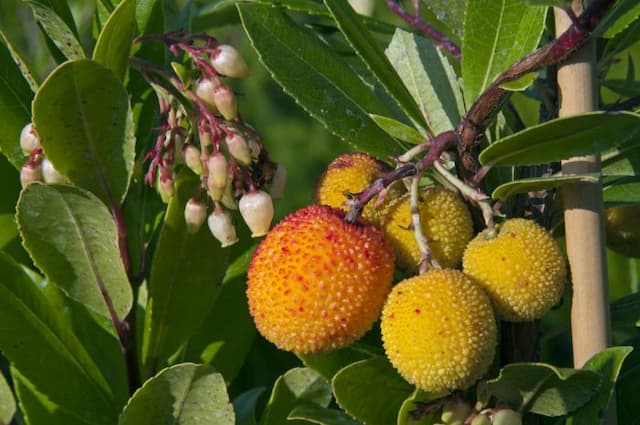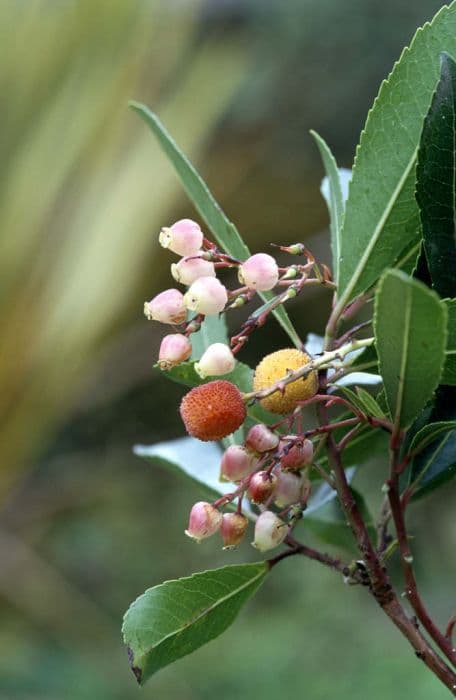Rhododendron Rhododendron 'Madame Masson'

ABOUT
The Rhododendron 'Madame Masson' is known for its striking appearance, characterized by its lush green foliage and vibrant flowers. This plant produces beautiful, broad leaves that are glossy and evergreen, offering a backdrop to its blossoms throughout the year. The flowers of 'Madame Masson' steal the show when they bloom. They emerge in clusters known as trusses, each comprising several individual flowers. These blooms are typically white with hints of yellow to golden markings at their throats, which is the inner part of the flower where it attaches to the stems. The petals are often slightly wavy at the edges, adding to the ornamental appeal of the plant. As a cultivar of the larger Rhododendron family, 'Madame Masson' upholds the family's reputation for showy, tubular to bell-shaped flowers that attract pollinators such as bees and butterflies. The visual impact of its blooming period makes this plant a favorite among gardeners seeking a burst of color in their landscape.
About this plant
 Names
NamesFamily
Ericaceae.
Synonyms
White Rhododendron, Madame Masson Rhododendron, Madame Masson Azalea.
Common names
Rhododendron 'Madame Masson'
 Toxicity
ToxicityTo humans
Rhododendrons, including the 'Madame Masson' variety, contain grayanotoxins, which are known to be toxic to humans if ingested. The ingestion of any part of the plant can lead to poisoning. Symptoms of rhododendron poisoning may include nausea, vomiting, diarrhea, hypersalivation, weakness, loss of energy, depression of the central nervous system, coma, and potentially death if a significant amount is consumed.
To pets
Rhododendrons are also toxic to pets, including the 'Madame Masson' variety. Similar to their effects on humans, the grayanotoxins in rhododendrons can cause symptoms such as vomiting, diarrhea, hypersalivation, weakness, and depression of the central nervous system in animals if any part of the plant is ingested. In severe cases, it can lead to coma and death, particularly if prompt veterinary treatment is not received.
 Characteristics
CharacteristicsLife cycle
Perennials
Foliage type
Evergreen
Color of leaves
Green
Flower color
White
Height
4-5 feet (1.2-1.5 meters)
Spread
4-6 feet (1.2-1.8 meters)
Plant type
Shrub
Hardiness zones
5
Native area
Asia
Benefits
 General Benefits
General Benefits- Ornamental Value: Strong visual appeal due to its large, beautiful white flowers with yellow to greenish spots.
- Attracts Pollinators: Provides a nectar source for bees, butterflies, and other beneficial insects.
- Versatile Landscaping: Can be used in mixed borders, as a specimen plant, or for mass planting in larger areas.
- Shade Tolerance: Grows well in partially shaded areas where other plants might not thrive.
- Privacy and Screening: Can be used as a dense shrub for privacy screening or as a windbreak when planted in groups.
- Seasonal Interest: Offers spring interest when in bloom and evergreen foliage for year-round texture and color.
- Soil Erosion Control: Extensive root system helps stabilize soil on slopes and prevent erosion.
- Cultural Significance: Often associated with certain cultures, symbolizing beauty and caution.
 Medical Properties
Medical PropertiesThis plant is not used for medical purposes.
 Air-purifying Qualities
Air-purifying QualitiesThis plant is not specifically known for air purifying qualities.
 Other Uses
Other Uses- Rhododendrons can be used as an ink source. Their petals, when crushed and mixed with a suitable binder, can create natural dyes for art and fabric projects.
- The wood of a rhododendron is very hard and can be used for making small handcrafted items such as bowls, handles, and even musical instruments.
- Leaves of the rhododendron can be used in floral displays, adding texture and greenery to arrangements.
- Rhododendron flowers can be crystallized with egg whites and sugar to create edible decorations for cakes and desserts.
- The fibrous roots of rhododendrons can be utilized in traditional weaving practices to create baskets and other woven goods.
- Rhododendron hedges are often used in landscape design to create privacy screens or windbreaks due to their dense foliage.
- The plant can provide a habitat for wildlife; birds often nest in the dense foliage, and the flowers can attract pollinating insects.
- Crushed rhododendron leaves have been used historically to create a natural insect repellent for storing clothes and linens.
- In bonsai, rhododendron plants can be trained into miniature forms, creating living art pieces through careful pruning and shaping.
- The plant's extensive root system can help stabilize soil on slopes and prevent erosion in landscaped gardens.
Interesting Facts
 Feng Shui
Feng ShuiThe Rhododendron is not used in Feng Shui practice.
 Zodiac Sign Compitability
Zodiac Sign CompitabilityThe Rhododendron is not used in astrology practice.
 Plant Symbolism
Plant Symbolism- Warning: Rhododendrons, including 'Madame Masson', are known to be poisonous, so they are often associated with caution and danger.
- Beware: In a historical context, they were sometimes used as a means to indicate that an area was hazardous.
- Temptation: Despite its toxicity, the plant's beautiful flowers can symbolize the allure of something that is harmful.
- Agility: The ability of rhododendrons to grow in difficult mountainous regions represents the overcoming of obstacles.
- Wealth: The lush, full bloom and evergreen nature can signify prosperity and abundance.
 Water
WaterRhododendrons, including 'Madame Masson', generally prefer evenly moist soil and require careful watering. It's best to water deeply when the top inch of soil feels dry to the touch, which for 'Madame Masson' might mean watering about once a week during the growing season, depending on climate and soil conditions. Provide approximately 1 gallon of water per watering for each shrub to ensure the root zone is sufficiently moistened. During periods of high heat or drought, the frequency may need to increase. It is crucial to avoid overwatering as it can lead to root rot; proper drainage is essential. Watering should be reduced in the fall and minimized in the winter as the plant requires less moisture during dormancy.
 Light
LightThe 'Madame Masson' rhododendron thrives best in partial shade, where it can receive filtered sunlight or morning sun with protection from the harsh afternoon rays. An ideal spot would be under the high canopy of trees that allows dappled sunlight to reach the plant, or on the north or east side of a building where it gets ambient light without the full intensity of the sun. Too much sun can lead to leaf scorch, while too little can reduce flowering.
 Temperature
TemperatureRhododendrons like 'Madame Masson' prefer moderate temperatures and can survive in a range between 20°F to 80°F, but they thrive in a zone where the temperatures remain between 50°F and 70°F. They are hardy to USDA zones 5 to 8. These plants can tolerate a brief period of temperatures slightly outside this range, but prolonged exposure to extremes can be damaging.
 Pruning
PruningRhododendrons like 'Madame Masson' should be pruned for shaping, to remove dead or diseased branches, and to promote vigorous growth. The best time to prune is soon after the flowers have finished blooming in the spring to avoid cutting off next year's buds. Light pruning every year or so will keep the shape compact and encourage healthier blooms. It's important not to prune too late in the season, as this can affect the flower production for the following year.
 Cleaning
CleaningAs needed
 Soil
SoilRhododendrons, including 'Madame Masson,' need well-draining, acidic soil with a pH of 4.5 to 6.0 for optimal growth. A mix containing peat moss, pine bark, and perlite is often recommended to ensure proper drainage and aeration. It is crucial to avoid lime and alkaline-based amendments, as these can negatively affect the plant's health by raising the pH beyond its preferred range.
 Repotting
RepottingRhododendrons like 'Madame Masson' generally do not need to be repotted frequently. Repotting every 2 to 3 years, or when they outgrow their current container, is adequate. Be careful not to damage the root system during repotting and ensure the new pot has adequate drainage holes.
 Humidity & Misting
Humidity & MistingRhododendron 'Madame Masson' thrives best in moderate to high humidity levels, ideally around 50-60%. Maintaining this level of humidity is particularly important during the dry winter months or if the plant is located in an environment with naturally low humidity levels.
 Suitable locations
Suitable locationsIndoor
Place 'Madame Masson' in bright, indirect light; keep soil moist.
Outdoor
Plant in partial shade, protect from wind, mulch, and water regularly.
Hardiness zone
5-8 USDA
 Life cycle
Life cycleThe Rhododendron 'Madame Masson', commonly known as Madame Masson Rhododendron, begins its life cycle as a seed, typically germinating when conditions of moisture, temperature, and light are favorable. After germination, it develops into a seedling, the stage at which roots establish in the soil and two initial leaves or cotyledons appear. As it enters the vegetative stage, the seedling grows into a young plant with a woody stem, more leaves, and a root system that expands to support growth. The plant matures over several years, developing a substantial structure capable of supporting the heavy flowering stage for which Rhododendrons are known. Flowering typically occurs in spring, with the Madame Masson variant producing large, white flowers with a yellow blotch, after which pollinated flowers will develop into seed-containing fruit. Finally, as an established perennial shrub, the Madame Masson Rhododendron can live for many years, going through repeated cycles of growth and dormancy, with pruning and care influencing its longevity and health.
 Propogation
PropogationPropogation time
Spring-Early Summer
The Rhododendron 'Madame Masson', commonly known as 'Madame Masson' Rhododendron, is typically propagated through semi-hardwood cuttings. This method is popular due to its effectiveness in producing true-to-type clones of the parent plant. The best time for taking cuttings is during the late summer months. To propagate, a cutting of about 4 to 6 inches (10 to 15 centimeters) long is taken from a healthy, semi-wooded branch. The lower leaves are removed, and the cut end is dipped into a rooting hormone to encourage root development. The cutting is then placed in a pot containing a mix of peat and perlite, ensuring it is kept moist and in a well-lit area without direct sunlight. Roots typically develop within a few weeks, after which the new plant can be potted on to grow into a mature 'Madame Masson' Rhododendron.









